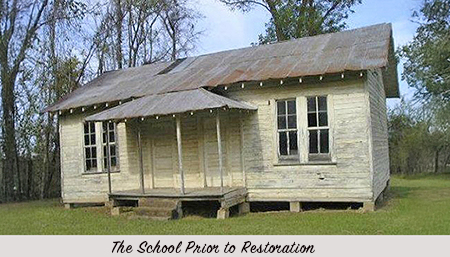
 Jefferson County, Mississippi
Jefferson County, MississippiA Proud Part of the Mississippi GenWeb!
Contact Us:
State Coordinator: Jeff Kemp
County Coordinator: Gerry Westmoreland

 Poplar Hill Museum of African American Culture was established in 2008. Originally, the site was home to Poplar Hill School, a rural public school that served the local African American community. According to documentation submitted to the National Register of Historic Places, the building was constructed around 1923 using locally sourced materials and built by members of the community and the Poplar Hill AME Church. The structure is rectangular, measuring 39 by 23 feet, providing 897 square feet of usable space. Modest in design, the school is a one-story wooden frame building resting on stone footings, clad in drop siding, and topped with a gabled metal roof.
Poplar Hill Museum of African American Culture was established in 2008. Originally, the site was home to Poplar Hill School, a rural public school that served the local African American community. According to documentation submitted to the National Register of Historic Places, the building was constructed around 1923 using locally sourced materials and built by members of the community and the Poplar Hill AME Church. The structure is rectangular, measuring 39 by 23 feet, providing 897 square feet of usable space. Modest in design, the school is a one-story wooden frame building resting on stone footings, clad in drop siding, and topped with a gabled metal roof.
The roots of African American education in Jefferson County extend back before the end of slavery. Although Mississippi law prohibited the education of enslaved people, many African Americans across the state managed to acquire literacy and then discreetly taught others. These informal lessons were often described by Freedmen’s Bureau Superintendent of Education John W. Alvord as “native schools.”
After the Confederate surrender in the lower Mississippi Valley in 1863, newly freed African Americans eagerly pursued educational opportunities. The American Missionary Association opened schools in Natchez and Vicksburg, staffed primarily by white teachers from the North. In parallel, African Americans began establishing their own community schools on plantations, including Poplar Hill, a 1,300-acre labor camp founded in 1841 by planter Samuel Scott on Coles Creek in Jefferson County.
The African Methodist Episcopal (AME) Church has maintained a continuous presence on the Poplar Hill site. The church supported a school for Black children there, known as Poplar Hill School, even before the Mississippi legislature mandated the establishment of public schools for both Black and white children in 1870.
Jefferson County’s first public schools opened in February 1871. Given the county’s Black majority, more schools were allocated to Black students, though only one of the six school directors was Black—Merriman Howard of Fayette. Howard was a notable figure, serving as a trustee of Alcorn University when it opened in 1871, as a state legislator from 1870 to 1872, and as sheriff of Jefferson County from 1872 to 1877.
Though oral history suggests that Poplar Hill School was informally founded in the late 1870s by formerly enslaved individuals from the Poplar Hill Plantation, the earliest documented records indicate the school was operating by 1897 within the church building. At that time, it was led by three Black trustees: Gibson Starks, John R. Thomas, and Scott Hamilton.
The first documented teacher at Poplar Hill was Elvira Ellis Jackson (1857–1925). She was the daughter of Isaiah Ellis from the Everton Plantation and Hennie Hence from the Auburn Hall Plantation, both in Jefferson County. Her husband, Fielding Jackson (1855–1890), had been born into slavery at Poplar Hill Plantation. Although records do not show where Elvira received her early education, she later attended summer “normal” (teacher-training) courses. In 1911, she passed a certification exam and earned a “second grade” teaching certificate, the second-highest qualification available at the time.
Poplar Hill School was originally intended to be a Rosenwald School, benefiting from the Julius Rosenwald Fund, which supported the construction of schools for African American students in the early 20th century. However, its development was hindered by Bura Hilbun, the state’s supervisor of Negro schools at the time. Hilbun was later found guilty of embezzling more than forty thousand dollars from the Rosenwald Fund, affecting multiple schools, including Poplar Hill. The school did receive some funding and was built around 1923, but its design did not fully conform to Rosenwald standards due to the misappropriation of funds. Hilbun’s case eventually reached the state supreme court, where he was sentenced to five years in prison, though he served only about two and a half years before his release. He passed away in 1948.
From 1957 through the 1970s, the former school building was used by local churches and community groups for meetings and events. Recognizing the historical significance of the building, former students such as Roosevelt Cruel, the late Sidney Jackson, and other community members began efforts in 2007 to preserve it. With the help of historians, preservationists, and public officials, they undertook the difficult but vital work of documenting the school’s legacy and restoring the building. Their efforts ensured that the history of Poplar Hill School—and the lives of those who taught and learned there—would be remembered and shared with future generations.
We are located in Jefferson County, MS about 3 miles off of Hwy 61.
Our contact information: On the subject box/line please use: Poplar Hill Museum
Mr. Roosevelt Cruel: shrlcru@aol.com
A. Stewart: a1656@aol.com
Tours are available by appointment - a small donation is requested.
Poplar Hill School is located at 3980 Poplar Hill Road, about 6 miles north-northwest of Fayette, MS. GPS: 31.763932, -91.093741